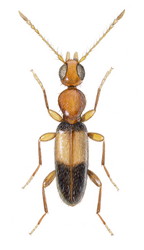Macratriinae
Dmitry Telnov- Camelomorpha Kirejtshuk, Azar,

- Macratria Newman, 1838
- Protomacratria Abdullah, 1964

- Salimuzzamania Abdullah, 1968
- Thambospasta Werner, 1974
Introduction
The Macratriinae are distributed all over the World but strictly avoid temperate regions and are most diverse in the tropics. Three recent and two fossil genera are known, of them Macratria Newman, 1838 is the largest and cosmopolitan one, while other genera are only represented by 1-2 species and have restricted distribution. In total, more than 200 species belong to this subfamily.
Characteristics
The main characters of the Macratriinae are: Frontoclypeal suture absent, frons gradually declivous. Mandibles long, bidentate at apex. Neck smooth and narrow, about 1/4 or less of maximum head width. Pronotum with distinct anterior collar which is of equal or almost equal width dorsally and ventrally. Antebasal sulcus well developed. Elytra elongate, densely pubescent and often punctured in rows. Mesosternum fused with mesepisterna, rarely triangular and free. Metacoxae narrowly separated by intercoxal projection. Tibial spurs long, distinct, paired. Sternite IX is V-shaped. Male genitalia with phallobase and separate parameres; penis free.
The genus Macratria is characterized by elytra having distinct longitudinal sulci along the lateral margin.
Genus Telesinus Fairmaire, 1903 was placed in Macratriinae by Chandler (2010) but clearly belongs to Eurygeniinae as defined by Telnov (2009).
Classification
Note: all taxa below are listed alphabetically.
- Camelomorpha Kirejtshuk, Azar, Telnov, 2008 - fossil from Lebanese amber (monotypic genus)
- Macratria Newman, 1838 - cosmopolitan
- Protomacratria Abdullah, 1964 - fossil from Baltic amber
- Salimuzzamania Abdullah, 1968 - Central America (monotypic genus)
- Thambospasta Werner, 1974 - USA (monotypic genus)
Biology and Ecology
Macratriinae have been found in various habitats, but seem to prefer tropical rainforests up to 3000 m elevation. Most Macratria are diurnal animals but they actively fly to light traps.
Representatives of Macratria are often very common on riparian vegetation, actively running on leaves or flying around. They are recorded from various species of herbs and shrubs, for example in Wallacea and on new Guinea - Areca sp. (Arecaceae), Arpinia sp. (Zingiberaceae), Ficus spp. (Moraceae), Leea sp. (Vitaceae), Piper spp. (Piperaceae), Theobroma cacao (Malvaceae), in New Zealand - Blechnum spp., Carex spp., Cyperus spp., Scirpus spp.) or Dysoxylum spp., Kunzea spp., Phyllocladus spp.
The imago of this group seems to be polyphagous.
References
Chandler D.S. 2010. 11.26. Anthicidae Latreille, 1819: 729-741. In: Leschen R.A.B., Beutel R.G., Lawrence J.F. (eds) Coleoptera, Beetles. Volume 2: Morphology and Systematics (Elateroidea, Bostrichiformia, Cucujiformia partim). Arthropoda Insecta. Handbook of Zoology. De Gruyter, Berlin & New York.
Telnov D. 2009. Review of the Genus Telesinus Fairmaire, 1903, with a General Discussion on African Eurygeniinae (Coleoptera: Anthicidae). – Mitteilungen des Internationalen Entomologischen Vereins e.V. 34, No. 3/4: 93-113.
Title Illustrations

About This Page
Dmitry Telnov

The Entomological Society of Latvia
Correspondence regarding this page should be directed to Dmitry Telnov at
Page copyright © 2011 Dmitry Telnov
All Rights Reserved.
- First online 06 January 2011
- Content changed 06 January 2011
Citing this page:
Telnov, Dmitry. 2011. Macratriinae. Version 06 January 2011 (under construction). http://tolweb.org/Macratriinae/145021/2011.01.06 in The Tree of Life Web Project, http://tolweb.org/








 Go to quick links
Go to quick search
Go to navigation for this section of the ToL site
Go to detailed links for the ToL site
Go to quick links
Go to quick search
Go to navigation for this section of the ToL site
Go to detailed links for the ToL site